Image diagnoses for "Scalp (hairy)"
120 results with 343 images
Results forScalp (hairy)
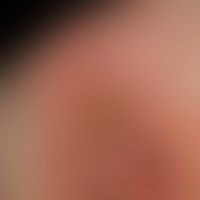
Pemphigoid scarring type brunsting-perry L12.1
Pemphigoid bullous, scarring, type Brunsting-Perry. For years, half-sided localized, therapy-resistant recurrent erosions and incrustations. In the dorsal part of the Os parietal area irritationless scarring.

Keratosis actinica keratotic type 57.00
Keratosis actinica keratotic type: 75-year-old man with multiple, differently sized horny, hard, partly sharply and partly blurredly bordered, rough plaques on excessively sun-damaged scalp.
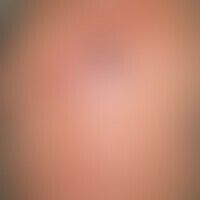
Squamous cell carcinoma of the skin C44.-
Squamous cell carcinoma in actinic pre-damaged scalp:Continuously growing keratoacanthoma of the scalp, existingfor about 7months, with a smooth surface and a broad base; multiple actinic keratoses.

Squamous cell carcinoma of the skin C44.-
Squamous cell carcinoma in actinic pre-damaged scalp:Continuously growing verrucous, broad-based, hard node of the scalp, existingfor severalmonths; multiple actinic keratoses.

Basal cell carcinoma (overview) C44.-
Basal cell carcinoma, nodular: Development of a basal cell carcinoma on a (congenital) sebaceous nevus. The carcinomatous transformation took place chronically insidiously without any symptoms. Only a recurring crust formation with intermediate weeping led to the pioneering biopsy.
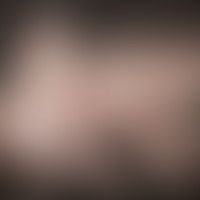
Tuft hair L66.2
Tufted hairs:Folliculitis decalvans; in the centre mirror-like scarring plate with wicklike hair tufts; in the marginal area of the scarring hair tufts with incised hair shafts.
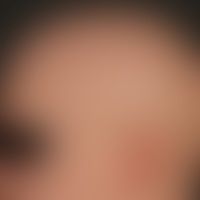
Alopecia areata (overview) L63.8
Alopecia areata totalis: Complete loss of hair on the capillitium, eyebrows and eyelashes, encircling an area of skin where the hair follicles that have been preserved are clearly visible.

Alopecia areata (overview) L63.8
Alopecia areata. roundish, centrifugally and medially spreading, smooth, hairless area with preserved follicles. in the active marginal area hairs can still be easily epilated.
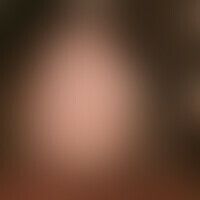
Alopecia areata (overview) L63.8
Alopecia areata: Large hairless area with preserved follicle structure.

Alopecia areata (overview) L63.8
Alopecia areata: marginal area of an apparently no longer progressive alopecia areata. follicular structures detectable. no cadaverized hair stumps detectable.
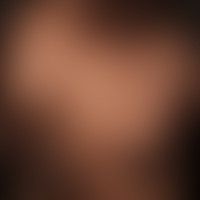
Alopecia areata (overview) L63.8
alopecia areata. roundish, centrifugally and medially spreading, smooth, skin-coloured, hairless areas with preserved follicles. total foci from single foci formed by confluence. follicular structures clearly detectable.

Folliculitis decalvans L66.2
Folliculitis decalvans: developmental stages of the disease over a period of 7 years.
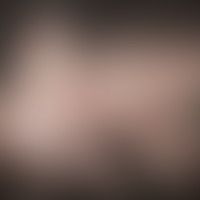
Folliculitis decalvans L66.2
Folliculitis decalvans. scarring hair loss that has been progressing for several years, with itching and occasional pain. in addition to purulent folliculitis, scaly tufts of hair with surrounding erythema appear.

Folliculitis decalvans L66.2
Folliculitis decalvans. 24 months of persistent scarring hair loss, with initially slight itching. In addition to purulent folliculitis, there are also incised tufts of hair with surrounding erythema and numerous small, shiny, hairless areas.
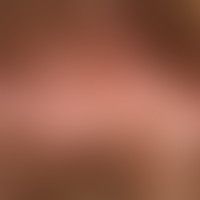
Folliculitis decalvans L66.2
Folliculitits decalvans: Close-up with shiny atrophy of the scalp and tufts of hair; the keatotic secretions are signs of the ongoing inflammatory process.

Folliculitis decalvans L66.2
Folliculitits decalvans: Scarring alopecia with shiny hairless area and tufts of hair at the edges.
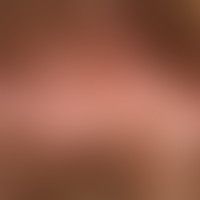
Tuft hair L66.2
Tufted hairs: Folliculitis decalvans, reflecting scar plate with wicklike hair tufts at the edges (see also under Folliculitis decalvans).
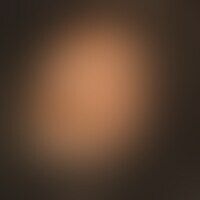
Aplasia cutis congenita (overview) Q84.81
Aplasia cutis congenita. 8.0 x 6.0 cm, yellowish-white alopecic focus with shiny surface, existing since birth, unchanged for years except for size increase during physical growth.

Frontal fibrosing alopecia L66.8
Alopecia postmenospausal fibrosing: typical single hairs; prominent follicular structure, stars denote double hairs.

Frontal fibrosing alopecia L66.8
alopecia postmenopausal, fibrosing, uniform receding of the frontal and temporal hairline. encircling a flat erythema originating from follicles. arrows: discrete perifollicular redness. distinct ulerythema ophryogenes with complete destruction of the eyebrows (square). keratosis follicularis on the extensor extremities.

Cornu cutaneum L85
Cornu cutaneum at the base of an actinic keratosis. 75-year-old man with considerable actinic damage to the skin.
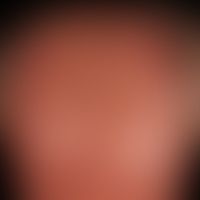
Keratosis actinica erythematous type L57.00
Keratosis actinica erythematous type: multiple red, rough, slightly painful papules and plaques on the bald head when stroking over them, continuously existing for years.

Alopecia androgenetica in men L64.-
Alopecia androgenetica in men. stage IV: confluence of anterior and posterior hair thinning in the parietal region.

Folliculitis decalvans L66.2
Folliculitis decalvans. 3 years of persistent scarring hair loss, with initially slight itching. In addition to purulent folliculitis, there are also incised tufts of hair with surrounding erythema and reflecting hairless areas.
